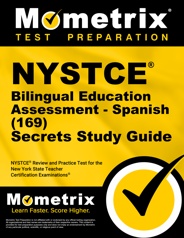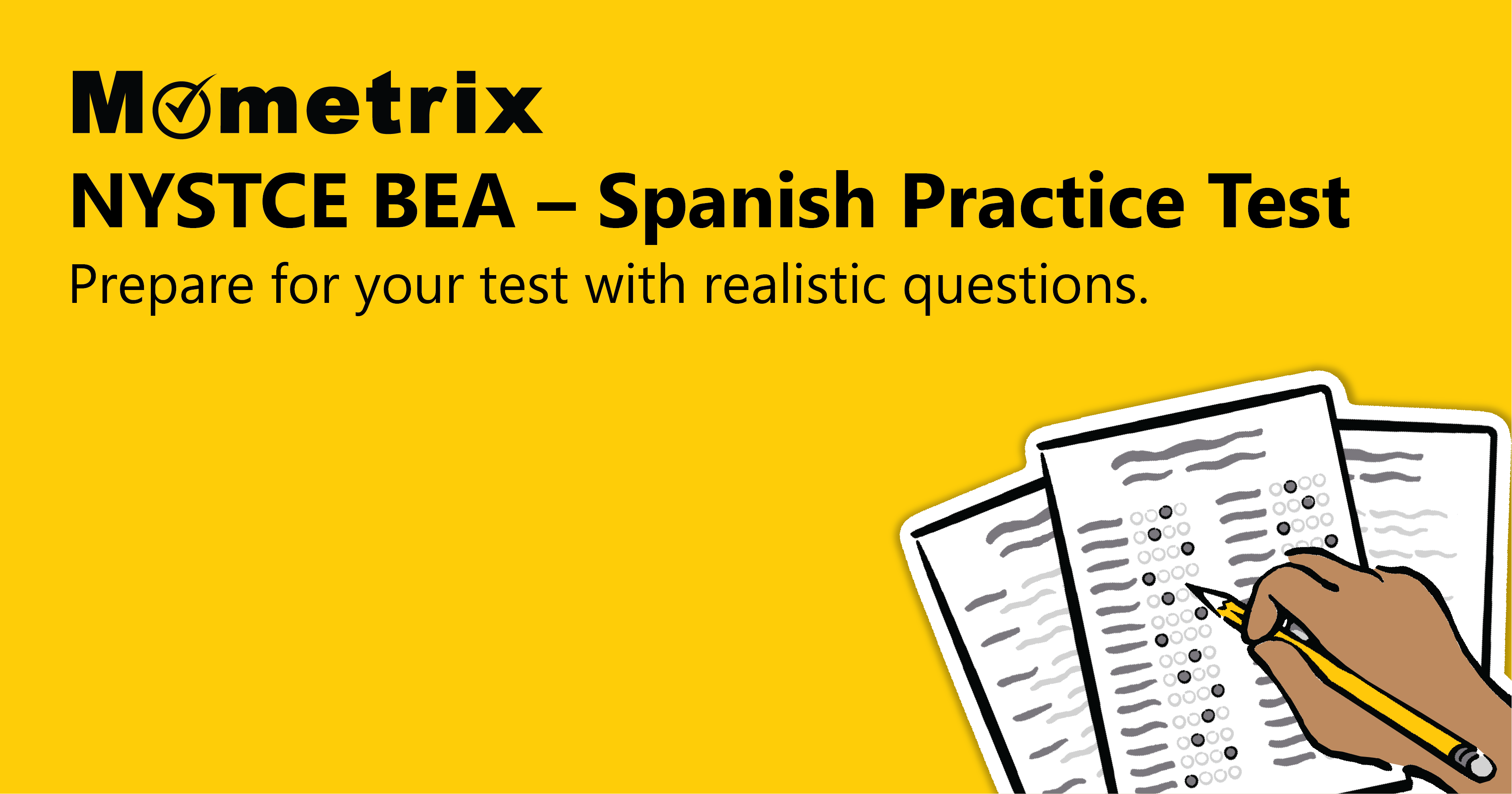The New York State Teacher Certification Exams program (NYSTCE) was designed for teachers in New York State to ensure proficiency in specific educational areas. The NYSTCE Bilingual Education Assessment (BEA) – Spanish exam is designed for prospective Spanish teachers in bilingual education programs in the state of New York.
Click “Start Test” above to take a free NYSTCE BEA — Spanish practice test, and check out our premium-quality NYSTCE test prep resources by clicking the links below!
NYSTCE BEA – Spanish Exam Outline
The NYSTCE BEA – Spanish exam contains 70 selected-response questions and three constructed-response questions, and you will be given a time limit of 3 hours and 25 minutes.
The exam is split into eight competencies.
1. Foundations of Bilingual Education: Knowledge of Content (18%)
- The characteristics and goals of the effectiveness of various types of bilingual education models and programs
- Current theories and research in home-language and new-language acquisition
- Differences between social, general-academic, and discipline-specific language
- The role and importance of transference in new language acquisition and literacy development
- The reciprocity between decoding and encoding
- The roles of phonemic awareness, phonics, fluency, vocabulary, and text comprehension in literacy development
- Identification of challenging aspects of English or Spanish
- Cognitive, metacognitive, and metalinguistic processes and strategies involved in learning a new language
- Creating a culturally responsive-sustaining classroom and learning environment that supports students’ cultures and linguistic identities
- Serving as a professional resource in the school community
- Using self-reflection and stakeholders’ feedback to inform and adjust instructional practices and professional behavior
- Setting goals for and engage in ongoing professional learning
2. Foundations of Bilingual Education: Knowledge of Pedagogy (14%)
- Establishing goals and expectations for bilingual education students that are aligned with relevant learning standards for language development and content learning
- Culturally responsive-sustaining research- and evidence-based principles of effective literacy instruction
- New York State academic learning standards
- The interdependence of language learning and content learning
- Designing inclusive instruction and learning environments that connect bilingual education students’ prior understanding and experiences to new knowledge
- Supporting bilingual education students’ content-area learning through scaffolding
- Assessment instruments and techniques for assessing bilingual education students’ discipline-specific language and literacy development and content-area learning
3. Interpretive Listening: English (10%)
- Identifying explicit and relevant information in a spoken message
- The use of register and sociolinguistic conventions in a variety of formal and informal contexts or situations
- Determining the meaning and nuances of words and phrases as they are used in spoken messages
- Recognizing greetings, questions, exchanges, or commands likely to be used in a social, educational, or professional context or situation
- Choosing an appropriate response to a question or comment
- Discerning and summarizing a speaker’s key ideas in a spoken message
- Making inferences or drawing conclusions based on the context, situation, and information given in a spoken message
4. Interpretive Listening: Spanish (12%)
- Identifying explicit and relevant information in a spoken message
- The use of register and sociolinguistic conventions in a variety of formal and informal contexts or situations
- Determining the meaning and nuances of words and phrases as they are used in spoken messages
- Recognizing greetings, questions, exchanges, or commands likely to be used in a social, educational, or professional context or situation
- Choosing an appropriate response to a question or comment
- Discerning and summarizing a speaker’s key ideas in a spoken message
- Making inferences or drawing conclusions based on the context, situation, and information given in a spoken message
5. Interpretive Reading: Spanish (12%)
- Identifying explicit and relevant information in a text
- Determining the meaning of words and phrases as they are used in texts
- Summarizing or paraphrasing the theme or central idea in a text
- Drawing logical inferences or conclusions based on the context, situation, and information given in a text
- Analyzing the communicative strategies and the social and cultural contexts of a text
- Analyzing the structure of an argument, the validity of reasoning, and the sufficiency and reliability of evidence presented in support of an argument in a text
6. Presentational Writing: Spanish (12%)
- Composing a logically sequenced, coherent, and effective written response to a prompt
- Determining appropriate language, style, and social and cultural writing conventions
- Introducing and supporting ideas and opinions with relevant details and examples
- Developing a conclusion that follows from and supports ideas presented in the composition
- Effectively expressing ideas in Spanish
- The conventions of grammar, orthography, punctuation, and other mechanics of Spanish
7. Presentational Speaking: English (10%)
- Composing a logically sequenced, coherent, and effective spoken response to a prompt
- Determining appropriate language, style, and social and cultural speaking conventions
- Addressing problems and supporting ideas and opinions with relevant details and examples
- Effectively expressing ideas in English
- Maintaining a flow of speech, with few nonproductive hesitations or pauses
- Demonstrating intelligible and clear pronunciation and intonation as appropriate
8. Presentational Speaking: Spanish (12%)
- Delivering a logically sequenced, coherent, and effective spoken response to a prompt
- Determining appropriate language, style, and sociolinguistic and cultural speaking conventions
- Addressing problems and supporting ideas and opinions with relevant details and examples
- Effectively expressing ideas in Spanish
- Maintaining a flow of speech, with few nonproductive hesitations or pauses
- Demonstrating intelligible and clear pronunciation and intonation as appropriate
Check Out Mometrix's NYSTCE Study Guide
Get practice questions, video tutorials, and detailed study lessons
Get Your Study Guide
Exam Registration
To register for the NYSTCE BEA – Spanish exam, you will need to create an NYSTCE account online and complete the registration process there. It is recommended that you complete the registration process at least 30 days before you take the exam.
During this process, you will be asked some questions about your educational history, as well as your current education level, first language, matriculation status, and the education code for the NYC Department of Education program type you are associated with.
The examination fee is $65.
The last day you can register for the current version of the test is February 15, 2024.
Test Day
You should arrive at the testing center 15-30 minutes earlier than the scheduled exam time. When you arrive, you will be asked to sign in and provide a valid form of government-issued photo ID.
Before the exam begins, you will be asked to place all personal items (cell phone, keys, wallet, accessories, etc.) in a locker outside the testing room, or you may be asked to leave them in your car.
Once the test begins, you will be allowed to take breaks. However, the timer will not be stopped during your break, so use your break time carefully.
How the Exam is Scored
Your total NYSTCE BEA – Spanish score is based on the number of questions you answered correctly, which is then reported as a numerical figure in the range of 400-600. To pass the exam, you must achieve a scaled score of 520.
You should receive your test results roughly 2-4 weeks after taking the exam. When you receive your score report, you will see your total score, your pass/fail status, and your scores for each subarea of the test.
Check Out Mometrix's NYSTCE Flashcards
Get complex subjects broken down into easily understandable concepts
Get Your Flashcards
FAQs
Q
How many questions are on the NYSTCE BEA – Spanish exam?
A
There are 70 selected-response questions and three constructed-response assignments on the exam.
Q
How long is the NYSTCE BEA – Spanish exam?
A
The time limit for the exam is 3 hours and 25 minutes.
Q
What is the passing score for the NYSTCE BEA – Spanish exam?
A
To pass the exam, you must achieve a minimum scaled score of 520.
Q
How much does the NYSTCE BEA – Spanish exam cost?
A
The examination fee is $65.
NYSTCE and New York State Teacher Certification Examinations are trademarks of the New York State Education Department and Pearson Education, Inc. or its affiliate(s). This page was developed by Mometrix Test Preparation. It was not developed in connection with Pearson Education, Inc., nor was it reviewed, approved or endorsed by these agencies.



